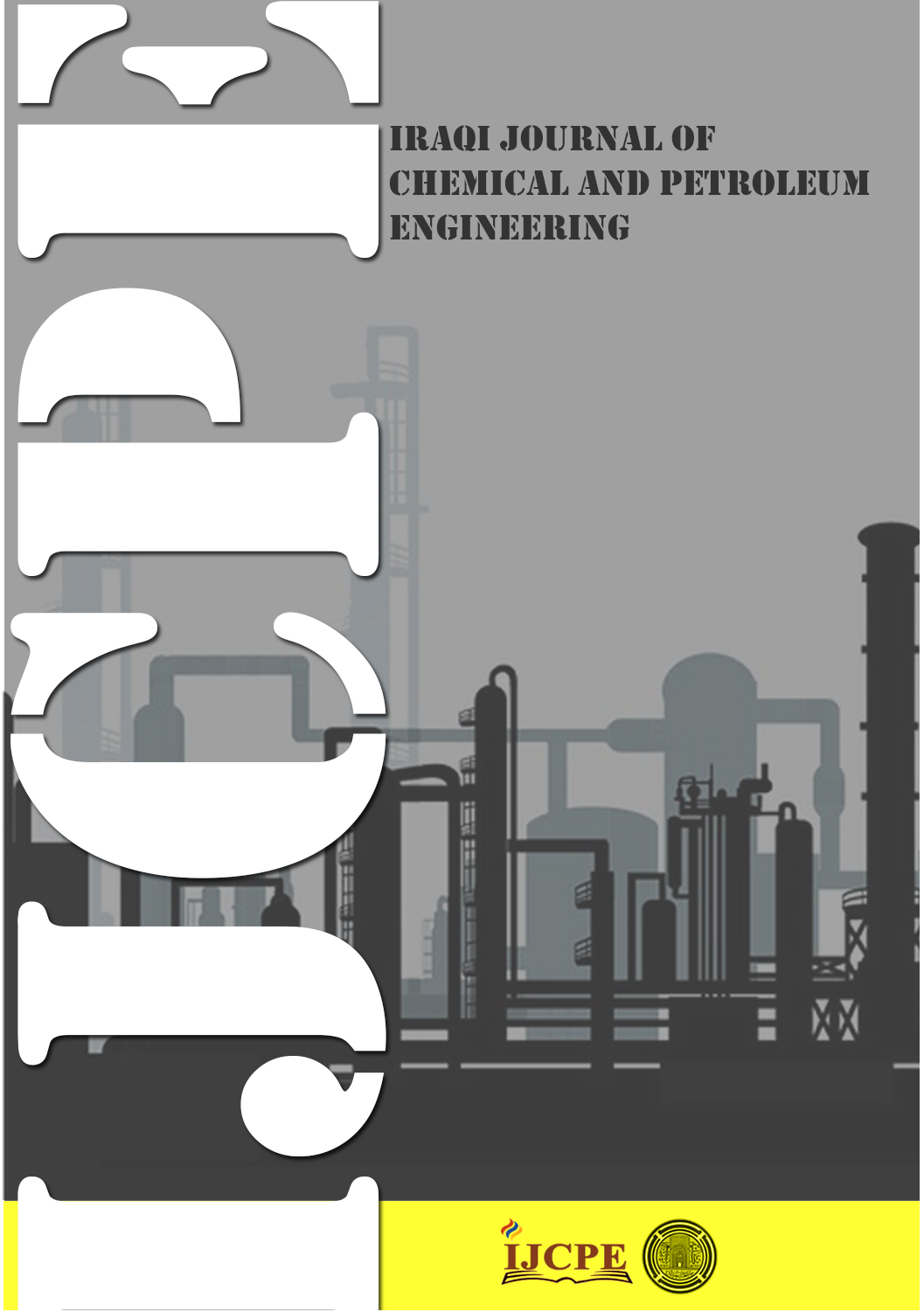Assessment of CO2 uptake on 13X zeolite by conducting batch and continuous fluidized tests
DOI:
https://doi.org/10.31699/IJCPE.2025.2.11Keywords:
CO2 capture; batch adsorption; isotherm study; kinetic study; continuous adsorption; breakthrough curve; fluidized bedAbstract
The development of new, cleaner technologies is presently receiving a lot of attention to capture pollutant CO2 gas. 13X zeolite is one of the most popular adsorbents employed for this purpose. Batch and continuous fluidized beds were used to examine the adsorption capacity. Isothermal and kinetic models for the batch were determined at 1–5 bar and 298 K and 303 K pressure range and temperatures, respectively. The Langmuir model fitted the process with qm = 4.01 mmol/g and a correlation R2 = 0.986. Pseudo-first order was also fitted with a correlation of R2 = 0.997. The impact of the inlet CO2 concentration (5%, 10%, and 14%), the bed heights varied between (5, 15, 25) cm, with a flow rate range of (6, 10, 14) L/min at temperature 298 K and pressure of 0.5 bar (gauge pressure), was investigated by utilizing the area under the breakthrough curve in a continuous fluidized bed experiment. Lower flow rate (6 l/m), bed height (25 cm), and higher CO2 initial concentration (14%) achieved the best results.
Received on 04/05/2024
Received in Revised Form on 01/10/2024
Accepted on 06/10/2024
Published on 30/06/2025
References
[1] F. Perera, A. Ashraf, P. Kinney, and D. Mills, “Towards a fuller assessment of benefits to children’s health of reducing air pollution and mitigating climate change due to fossil fuel combustion”, Environmental Research., vol. 172, pp. 55–72, 2019. https://doi.org/10.1016/j.envres.2018.12.016
[2] F. Perera, “Pollution from fossil-fuel combustion is the leading environmental threat to global pediatric health and equity: solutions exist”, International Journal of Environmental Research and Public Health, 15:16, 2018. https://doi.org/10.3390/ijerph15010016
[3] M. H. Eldesouki, A. E. Rashed, and A. Abd El Moneim, “A comprehensive overview of carbon dioxide, including emission sources, capture technologies, and the conversion into value added products”, Clean Technologies and Environmental Policy, vol. 25, pp. 3131–3148, 2023. https://doi.org/10.1007/s10098-023-02599-9
[4] G. A. Mohammed and A. A. Shneat, “Parameters Affecting the Thermodynamic Efficiency of PEM Single Cell and Stack of Cells (Two Cells)”, Iraqi Journal of Chemical and Petroleum Engineering, vol. 17 (3), pp. 91- 100, 2016. https://doi.org/10.31699/IJCPE.2016.3.8
[5] T. Mendiara, F. García-Labiano, A. Abad, P. Gayán, L. F. de Diego, M. T. Izquierdo, and J. Adánez, “Negative CO2 emissions through the use of biofuels in chemical looping technology: A review”, Applied Energy, vol. 232, pp. 657-684, 2018. https://doi.org/10.1016/j.apenergy.2018.09.201
[6] Z. L. Ooi, P. Y. Tan, L. S. Tan, and S. P. Yeap, “Amine-based solvent for CO2 absorption and its impact on carbon steel corrosion: A perspective review”, Chinese journal of chemical engineering, vol. 28(5), pp. 1357-1367, 2020. https://doi.org/10.1016/j.cjche.2020.02.029
[7] G. Chen, T. Wang, G. Zhang, G. Liu, and W. Jin, “Membrane materials targeting carbon capture and utilization”, Advanced Membranes, vol. 2, 100025, 2022. https://doi.org/10.1016/j.advmem.2022.100025
[8] S. N. Zuraidi and H. Husin, “A Comparative Analysis Of Cryogenic, Adsorption And Amine-Based Absorption Techniques For Co2 Capture”, Platform: A Journal of Engineering, vol. 7(4), 2023. https://doi.org/10.61762/pajevol7iss4art25235
[9] B. I. Waisi, J. T. Majeed and N. S. Majeed, “Carbon dioxide capture using nonwoven activated carbon nanofiber”, Earth and Environmental Science, vol. 779, 2021. https://doi.org/10.1088/1755-1315/779/1/012056
[10] N. Abuelnoor, A. AlHajaj, M. Khaleel, L. F. Vega, M. R. M. Abu-Zahra, “Activated carbons from biomass-based sources for CO2 capture applications”, Chemosphere, vol. 282, pp. 131111, 2021. https://doi.org/10.1016/j.chemosphere.2021.131111
[11] S. M. Al-Jubouri, “The static aging effect on the seedless synthesis of different ranges Faujasite-type zeolite Y at various factors”, Iraqi Journal of Chemical and Petroleum Engineering, vol. 20(4), pp. 7-13, 2019. https://doi.org/10.31699/IJCPE.2019.4.2
[12] J. T. Majeed and N. S. Majeed, “Taguchi Design Methodology for the Optimization of CO2 Permeance in Gas Capture Process from Polluted Air”, Environmental Earth Sciences, vol. 1215, 2023. https://doi.org/10.1088/1755-1315/1215/1/012010
[13] Y. Lv, Q. Sun, J. Li, W. Zhange, Y. He, and Y Zhou, “Disability Status and Its Influencing Factors Among Stroke Patients in Northeast China: A 3-Year Follow-Up Study”, National Library of Medicine, vol. 17, pp. 2567-2573, 2021. https://doi.org/10.2147/NDT.S320785
[14] S. M. Okhovat-Alavian, J. Behin, and N. Mostoufi, “Investigating bubble dynamics in a semi-cylindrical gas-solid fluidized bed”, Powder Technology, vol. 370, pp. 129-136, 2020. https://doi.org/10.1016/j.powtec.2020.05.032
[15] S. K. Govindarajan, A. Mishra, and A. Kumar, “Darcy’s Experimental Empirical Relation and its Extension”. LARHYSS JOURNAL, vol. 42, pp. 7-22, 2020.
[16] R. Girimonte, B. Formisani, and F. Testa, “Adsorption of CO2 on a confined fluidized bed of pelletized 13X zeolite”, Powder Technology, vol. 311, pp. 9-17, 2017. https://doi.org/10.1016/j.powtec.2017.01.033
[17] E. Khoramzadeh, M. Mofarahi, K. Chungand, and C.-H. Lee, “Equilibrium Adsorption Study of CO2 and N2 on Synthesized Zeolites 13X, 4A, 5A, and Beta”, Journal of Chemical & Engineering Data, vol. 64 (12), 2019. https://doi.org/10.1021/acs.jced.9b00690
[18] M. Alibolandi, S. M. Sadrameli, F. Rezaee, and J. T. Darian, “Separation of CO2/N2 mixture by vacuum pressure swing adsorption (VPSA) using zeolite 13X type and carbon molecular sieve adsorbents”, Heat and Mass Transfer, vol. 56, pp. 1985–1994, 2020. https://doi.org/10.1007/s00231-020-02823-y
[19] F. Fashi, A. Ghaemi, and A. H. Behroozi, “Piperazine impregnation on Zeolite 13X as a novel adsorbent for CO2 capture: experimental and modeling”, Chemical Engineering Communications, vol. 208(24), pp.1-17, 2021. https://doi.org/10.1080/00986445.2020.1746657
[20] Aloko, D. F., and Eyitayo Amos Afolabi. "Titanium dioxide as a cathode material in a dry cell." Leonardo Electronics Journal of Practices and Technologies, vol. 11, pp. 97-108, 2007.
[21] B. Guo, L. Chang, and K. Xie, “Adsorption of carbon dioxide on activated carbon”, Journal of Natural Gas Chemistry, vol. 15, pp. 223-229, 2006. https://doi.org/10.1016/S1003-9953(06)60030-3
[22] Temkin M.I., “Adsorption Equilibrium and the Kinetics of Processes on Nonhomogeneous Surfaces and in the Interaction between Adsorbed Molecules”, Russian Journal of Physical Chemistry A, vol. 15, pp. 296-332, 1941.
[23] J. S. Piccin, G. Dotto, and L. A. A. PINTO, “Adsorption isotherms and thermochemical data of FD and C RED N° 40 Binding by chitosan”, Brazilian Journal of Chemical Engineering, vol. 28(2), pp. 295-304, 2011. https://doi.org/10.1590/S0104-66322011000200014
[24] O. Çelebi, Ç. Üzüm, T. Shahwan, and H.N. Erten, “A radiotracer study of the adsorption behavior of aqueous Ba2+ ions on nanoparticles of zero-valent iron”, Journal of Hazardous Materials, vol. 148(3), pp. 761–767, 2007. https://doi.org/10.1016/j.jhazmat.2007.06.122
[25] K. Vijayaraghavan, T.V.N. Padmesh, K. Palanivelu, and M. Velan, “Biosorption of nickel (II) ions onto Sargassum wightii: Application of two parameter and three-parameter isotherm models”, Journal of hazardous materials, vol. 133(1–3), pp. 304–308, 2006. https://doi.org/10.1016/j.jhazmat.2005.10.016
[26] C. Theivarasu, and S. Mylsamy, “Removal of malachite green from aqueous solution by activated carbon developed from cocoa (Theobroma Cacao) shell-A kinetic and equilibrium studies”, E-Journal of Chemistry, vol. 8(S1), pp. S363–S371, 2011. https://doi.org/10.1155/2011/714808
[27] C. Goel, H. Kaur, H. Bhunia, and P.K. Bajpai, “Carbon dioxide adsorption on nitrogen enriched carbon adsorbents: experimental, kinetics, isothermal and thermodynamic studies”, Journal of CO2 Utilization, vol. 16, pp. 50-63, 2016. https://doi.org/10.1016/j.jcou.2016.06.002
[28] M. H. Mohammed Ali, R. F. Almilly, and R. K. Abid, “Isotherms and Kinetics Study for Adsorption of Nitrogen from Air using Zeolite Li-LSX to Produce Medical Oxygen”, Iraqi Journal of Chemical and Petroleum Engineering, vol. 24 (2), pp. 81-87, 2023. https://doi.org/10.31699/IJCPE.2023.2.9
[29] W. J. Weber and J. C. Morris, “Kinetics of adsorption on carbon from solution”, Journal of the Sanitary Engineering Division, vol. 89, pp. 31-60, 1963. https://doi.org/10.1061/JSEDAI.0000430
[30] R. S. Juang, and M.L. Chen, “Application of the Elovich equation to the kinetics of metal sorption with solvent-impregnated resins”, Industrial & Engineering Chemistry Research., vol. 36(3), pp. 813–820, 1997. https://doi.org/10.1021/ie960351f
[31] R. Girimonte, B. Formisani, and F. Testa, “Adsorption of CO2 on a confined fluidized bed of pelletized 13X zeolite”, Powder Technology, vol. 311, pp. 9–17, 2017. https://doi.org/10.1016/j.powtec.2017.01.033
[32] M. J. Ahmed and S. K. Theydan, “Isotherms and thermodynamics studies for binary adsorption of methane and ethane on 4A molecular sieve zeolite”, Journal of Porous Materials, vol. 21, pp. 303–310, 2014. https://doi.org/10.1007/s10934-013-9775-2
[33] S. E. Ebrahim and F. A. Rasheed, “Removal of Copper Ions onto Walnut Shells by Using Batch and Continuous Fluidized Bed”, Journal of Engineering, vol. 19 (08), 2013. https://doi.org/10.31026/j.eng.2013.08.04
[34] H. Chang, Z. Wu, M. Yao, S. Guo, “Experimental Investigation and Modeling of Adsorption of Carbon Dioxide on 5A Molecular Sieve for Helium Purification of High-Temperature Gas-cooled Reactor”, Energy Procedia, vol. 39, pp. 208-226, 2012. https://doi.org/10.1016/j.egypro.2013.07.208
[35] A. I. Sarker, A. Aroonwilas, and A. Veawab, “Equilibrium and Kinetic Behavior of CO2 Adsorption onto Zeolites, Carbon Molecular Sieve and Activated Carbons”, Energy Procedia, vol. 114, pp. 2450 – 2459, 2017. https://doi.org/10.1016/j.egypro.2017.03.1394
[36] J. Shabanian and J. Chaouki, “Effects of temperature, pressure, and interparticle forces on the hydrodynamics of a gas-solid fluidized bed”, Chemical Engineering Journal, vol. 313, pp. 580–590, 2017. https://doi.org/10.1016/j.cej.2016.12.061
[37] E. Khoramzadeh, M. Mofarahi, and C. Lee, “Equilibrium Adsorption Study of CO2 and N2 on Synthesized Zeolites 13X, 4A, 5A, and Beta”, Journal of Chemical and Engineering, vol. 64, pp. 5648–5664, 2019. https://doi.org/10.1021/acs.jced.9b00690
[38] A. I. Sarkera, A. Aroonwilasa, and A. Veawab, “Equilibrium and Kinetic Behaviour of CO2 Adsorption onto Zeolites, Carbon Molecular Sieve and Activated Carbons”, Energy Procedia, vol. 114, pp. 2450–2459, 2017. https://doi.org/10.1016/j.egypro.2017.03.1394
[39] J. Hedlund, G. Garcia, M. Balsamo, M. Zhou, and J. Mouzon, “Microchannel zeolite 13X adsorbent with high CO2 separation performance”, Separation and Purification Technology, vol. 277, 119483, 2021. https://doi.org/10.1016/j.seppur.2021.119483
[40] N. S. Majeed and S. A. Alwan, “Study the Performance of Low Cost Material (Peanut Hulls) for Dye Adsorption Using Inverse Fluidized Bed”, Iraqi Journal of Chemical and Petroleum Engineering, vol.15 (2), pp. 15- 25, 2014. https://doi.org/10.31699/IJCPE.2014.2.3
[41] M. Auta and B.H. Hameed, “Preparation of waste tea activated carbon using potassium acetate as an activating agent for adsorption of Acid Blue 25 dye”, Chemical Engineering Journal, vol. 171(2), pp. 502–509, 2011. https://doi.org/10.1016/j.cej.2011.04.017
[42] M. Auta and B.H. Hameed, “Adsorption of carbon dioxide by diethanolamine activated alumina beads in a fixed bed”, Chemical Engineering Journal, vol. 253, pp. 350–355, 2014. https://doi.org/10.1016/j.cej.2014.05.018
Downloads
Published
Issue
Section
License
Copyright (c) 2025 The Author(s). Published by College of Engineering, University of Baghdad.

This work is licensed under a Creative Commons Attribution 4.0 International License.













